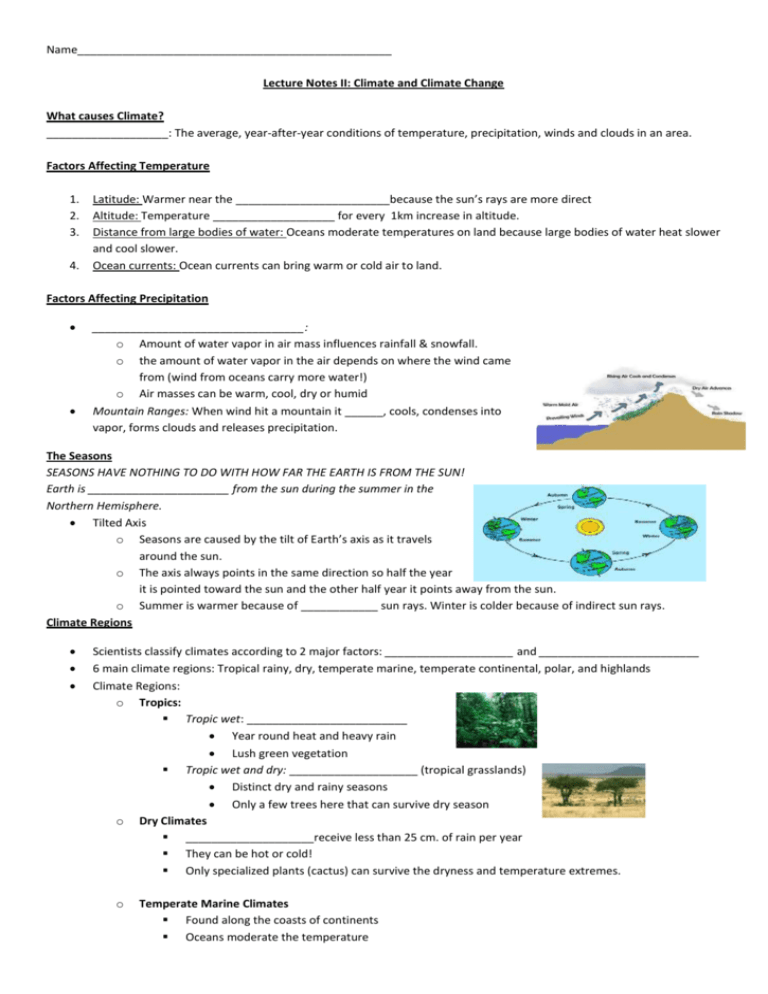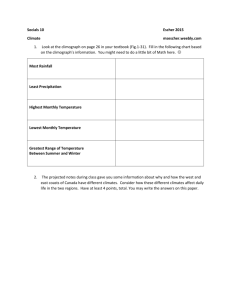Lecture Notes II
advertisement

Name_________________________________________________ Lecture Notes II: Climate and Climate Change What causes Climate? ___________________: The average, year-after-year conditions of temperature, precipitation, winds and clouds in an area. Factors Affecting Temperature 1. 2. 3. 4. Latitude: Warmer near the ________________________because the sun’s rays are more direct Altitude: Temperature ___________________ for every 1km increase in altitude. Distance from large bodies of water: Oceans moderate temperatures on land because large bodies of water heat slower and cool slower. Ocean currents: Ocean currents can bring warm or cold air to land. Factors Affecting Precipitation _________________________________: o Amount of water vapor in air mass influences rainfall & snowfall. o the amount of water vapor in the air depends on where the wind came from (wind from oceans carry more water!) o Air masses can be warm, cool, dry or humid Mountain Ranges: When wind hit a mountain it ______, cools, condenses into vapor, forms clouds and releases precipitation. The Seasons SEASONS HAVE NOTHING TO DO WITH HOW FAR THE EARTH IS FROM THE SUN! Earth is ______________________ from the sun during the summer in the Northern Hemisphere. Tilted Axis o Seasons are caused by the tilt of Earth’s axis as it travels around the sun. o The axis always points in the same direction so half the year it is pointed toward the sun and the other half year it points away from the sun. o Summer is warmer because of ____________ sun rays. Winter is colder because of indirect sun rays. Climate Regions Scientists classify climates according to 2 major factors: ____________________ and _________________________ 6 main climate regions: Tropical rainy, dry, temperate marine, temperate continental, polar, and highlands Climate Regions: o Tropics: Tropic wet: _________________________ Year round heat and heavy rain Lush green vegetation Tropic wet and dry: ____________________ (tropical grasslands) Distinct dry and rainy seasons Only a few trees here that can survive dry season o Dry Climates ____________________receive less than 25 cm. of rain per year They can be hot or cold! Only specialized plants (cactus) can survive the dryness and temperature extremes. o Temperate Marine Climates Found along the coasts of continents Oceans moderate the temperature o o o Humid Have mild winters Temperate Continental Climates Not influenced by oceans Have extremes of temperature Polar Climates Coldest climate region _____________: Climate region with avg. temperatures at or below freezing, and covered with ice and snow. Tundra: climate region with short cool summers and bitterly cold winters (more life than in icecap) Permafrost: ______________________________________________ ____________________________: Places with high altitudes Temperature falls with increasing altitude so these regions are colder than those surrounding them. Precipitation increases (air masses carrying moisture over highlands) Studying Climate Change _______________________: pollen (from bottom of lakes and inside earth) give us information about ancient plants and therefore ancient climates. Tree rings: Trees grow a new layer of wood each summer and scientists study the pattern of rings and determine if previous years were warm, cool, wet or dry. o Cool climates: thickness of tree ring depends on length of warm growing season. o Dry climates: Thickness depends on amount of _________________ Causes of Major Climate Change 1. ___________________________: Angle of Earth’s tilt and shape of orbit change slightly over time (may cause ice ages) 2. Solar Energy: Sunspots are dark, ___________________ regions on the sun’s surface, and they increase/decrease in 11year cycles. When there are more sunspots the sun produces more energy (increase Earth’s temp.) 3. Volcanic Activity: Release of _____________________ block solar radiation and cool the planet. 4. Movement of Continents: These changes affect global patterns of winds and ocean currents, and therefore the climate. Short Term Climate Change Changes in ocean currents and wind can greatly affect climate. _______________: Warm water event when unusual patterns of winds form over the western Pacific. Occurs every 2-7 years, changes weather patterns and can cause heavy rains or droughts for South America. La Nina: ____________________ event in Eastern Pacific that changes climate and brings colder winters, greater precipitation to USA, and more hurricanes. Global Warming Most changes in climate occur ________________________ Recently, human activities have caused climate change. Human activities have added _______________________________ to the environment, trapping heat and making Earth warmer. More carbon dioxide emissions (cars, planes, industries) causes more heat to be trapped. ________________layer is being destroyed by human activity (CFCs) and letting in harmful UV rays to Earth.











